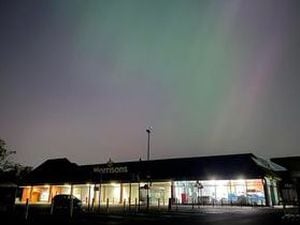Impressive steel sculpture to be installed at Dudley Zoo highlighting plight of orangutans
It's an all too common plight – a mother orangutan trying to reach her baby in the wake of devastating deforestation which has left them without a home.

And it's a prominent message which will be highlighted to visitors at Dudley Zoo and Castle through a piece of eye-catching steel artwork by Black Country artist Luke Perry.
The piece, which has taken around six months to make, features around 100 steel poles of which 97 are cut to knee-height to represent deforestation.
And at the heart of the work is a female Bornean orangutan who is clinging on to two of the remaining poles, trying to reach out to her young child.
The young orangutan is situated on the third pole but is just out of reach to his mother – an emotional message to hammer home the plights they face.
It follows on from another piece of artwork by the Cradley artist which has taken pride of place in the lemur exhibit after it was unveiled two years ago.
Mr Perry said: "I'm very concerned about the environment and the zoo have got brilliant policies towards their animals and raising awareness.
"We started talking about how to draw attention to the plights of the animals, so with lemurs it was subjects like deforestation and poaching and other concerns there are. People responded to it very well and off the back of that, we thought about doing something about the orangutans and their plight.
"The key point we're working on is that 97 per cent of orangutans' habitat has been lost, leaving only three per cent left. I wanted to do 100 poles, 97 of which are cut at around knee-height to resemble a forest to show that.
"And then we have the mother orangutan holding onto two and her baby is holding onto one, but they can't reach each other. It's an easy-to-understand message because we haven't got the time for a lack of interpretation – people need to see that key message."
The artist added that much of deforestation had been caused by palm oil – which can be found in some cake, biscuits, frying fats and other items and can have a major impact on habitats when it is extracted.
The bold work has taken around six months so far and is almost complete, with the last stage involving it being galvanised to ensure it lasts a long time, but it hasn't all been plain sailing for the well-known metal artist.
"Steel is a very hard medium, it's often very flat and it's great for structural things – but orangutans are well known for their softness, for their hair and for their organic shapes, so the difficulty was really to make something which complements that," he said.
And another difficulty was the similarity between the mammals and humans, with Mr Perry joking it was tempting to "almost make a sort of hairy human" during the process – but he was determined to get it right.
"It takes a lot of study and I studied measurements taken from books," he said. "You don't really get them very often in the poses I was looking at either. I took hundreds of photos at the zoo and they're always bunched up because it's colder here in Britain, but I was looking for some dramatic poses."
The 39-year-old, whose business Industrial Heritage Stronghold is carbon-neutral due to off-setting carbon, said he ended up using clay models to design the critically-endangered mammals which he was able to then scale up – saying he had used 21st century technology along with 13th century to make it happen.
The poles are around six metres tall, with the orangutan mother measuring three metres from fingertip to fingertip and over two metres tall. The baby orangutan, if stood up, would measure the same as an eight-year-old girl – around one-and-a-half metres.
"It will go outside their habitat and it forms part of the much wider interpretation that Dudley Zoo have done – they've done a really incredible job putting information around the exhibits so people can understand the plight of these animals," he added.
The piece, which will likely be installed later this year, will be installed around the new orangutan enclosure for the species at the zoo which expanded following the summer arrivals of babies Jim and Joe. It opened up earlier this year.
Zoo director Derek Grove said: “Back in 2020, Luke unveiled the giant steel lemur statue in our walkthrough lemur exhibit, which has proved to be a great conservation talking point for visitors.
“As part of our themed interpretation around the new Bornean orangutan enclosure, which completed earlier this year, we wanted various striking elements to help reinforce our conservation messages to visitors about palm oil, deforestation and the sad plight of the species.
“Luke’s artwork, which features a mum and baby orangutan, will certainly get visitors stopping in their tracks and, we hope, then taking action in the fight against the extinction of the magnificent great ape.”
Alongside the investment into the animal facilities, the attraction has pledged £100,000 over a five-year period to the Sintang Orangutan Center in Indonesia, the native homeland of the species, which specialises in the rescue, rehabilitation and release of orangutans, alongside raising awareness and educating local people in a bid to reduce deforestation and stop illegal poaching.





